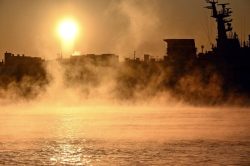Seto Ohashi Bridge: Spectacular View from Service Corridor; Views of Sea, Islands, Trains Stun

Participants of the Seto Ohashi Bridge Backyard Tour walk along the 45-meter-high maintenance walkway in Sakaide, Kagawa Prefecture.
10:14 JST, December 21, 2024
OKAYAMA — I have crossed the Seto Ohashi Bridge many times for sightseeing and for work as a journalist based in Okayama. It always feels great to drive over the bridge, which connects Honshu and Shikoku, while looking out over the seascape with islands scattered throughout the blue water.
I recently had a chance to join the Seto Ohashi Bridge Backyard Tour for a walk along the bridge’s service corridors, which are normally off-limits to the public.
Okayama and Kagawa prefectural governments along with the Honshu-Shikoku Bridge Expressway Co. have jointly been holding the tour since last year, giving participants the chance to see behind the scenes of the bridge through the eyes of the maintenance crew. This year, the tour was conducted eight times from Nov. 9-10.
I joined the Nov. 9 tour on the 850-meter-long Yoshima Bridge, one of the bridges that make up the Seto Ohashi Bridge. Yoshima Bridge connects Yoshima Island and Wasa Island in Sakaide, Kagawa Prefecture. I drove from Okayama to Yoshima Parking Area, the meeting place, with high expectations.
After passing through the Washuzan Tunnel in Kurashiki, Okayama Prefecture, the Seto-Chuo Expressway emerges over the sea. I drove for a while, following the signs, before turning onto a side road that brought me to Yoshima Parking Area, where I met up with the about 20 participants, who had been chosen by lottery.
Structural beauty
After listening to a Honshu-Shikoku Bridge Expressway guide, we put our helmets on and set off. We walked from the parking area along a path, which gradually became uphill for about a kilometer until we reached a high ground where a huge bridge pier stands.

A bearing supports the bridge girder. Each bearing is designed to support a load of 11,100 tons.
We went down a spiral staircase and found ourselves on the service corridor 45 meters above the sea.
Looking up from the walkway, we saw a number of steel frames forming triangles. A bridge like this, where small pieces of the structure are joined into a series of interconnected triangles to reinforce the bridge girder, is called a truss bridge, according to the guide’s explanation.
I was fascinated by its structural beauty. And then I caught sight of Wasa and Iwakuro islands. Wasa is uninhabited, but there are people living on Iwakuro, many of whom have a connection to fishing.
We went down some steps to find a large bridge bearing, a component that supports the girder. I was surprised by the explanation that each bearing is designed to support a load of 11,100 tons.
Trains below
One of the highlights of the tour is a bird’s-eye view of trains crossing the bridge.

The Marine-Liner crosses the Seto Ohashi Bridge.
We went back up the stairs and walked along a long passageway, the floor of which was covered in grating for wind resistance.
Looking down through the grating, I went weak in the knees at the sight of the expansive sea.
I also got tired from climbing up and down the steep stairs. I kept walking, nevertheless, telling myself I couldn’t stop, since there were people on the tour older than me. And there were the railway tracks below us.
About 150 trains cross the Seto Ohashi Bridge every day. Whenever one of them roared by, participants yelled and held their cameras up in sync, trying to capture the moment on film.
After walking the 3-kilometer round trip in about 90 minutes, I was worn out when I got back to the parking area. However, the feeling of elation we experienced from seeing the spectacular view was irreplaceable.
I also felt a growing sense of gratitude toward the workers who provide maintenance checks on the main artery connecting Honshu and Shikoku using those corridors we walked.
In addition to the Seto Ohashi Bridge Backyard Tour, there is also a tour that takes participants to the top of the bridge tower.
I headed home determined to sign up again for another spectacular view.
The Seto Ohashi Bridge

The world’s largest combined road-rail bridge was completed in 1988. It is 13 kilometers long and consists of three suspension bridges, two cable-stayed bridges and one truss bridge. It carries about 23,000 cars and 150 trains a day. About 1,500 ships pass under it daily.
Related Tags
"Features" POPULAR ARTICLE
-

Sanrio to Open Museum in Yamanashi Pref. Dedicated to Founder, Exhibits Include Hello Kitty, Other Characters
-

Autumn Foliage Surrounds Visitors to Tokyo’s Showa Kinen Park
-

My Daughter No Longer Speaks to Me, But I Want to See Her and My Grandchild
-

Kumamoto: Public Bath Refurbished as Library Where You Can Chat, Take Photos
-

Frozen Vegetables: Demand Rises for Convenient, Tasty Domestic Produce
JN ACCESS RANKING
-

Tokyo Economic Security Forum to Hold Inaugural Meeting Amid Tense Global Environment
-

Keidanren Chairman Yoshinobu Tsutsui Visits Kashiwazaki-Kariwa Nuclear Power Plant; Inspects New Emergency Safety System
-

Imports of Rare Earths from China Facing Delays, May Be Caused by Deterioration of Japan-China Relations
-

University of Tokyo Professor Discusses Japanese Economic Security in Interview Ahead of Forum
-

Japan Pulls out of Vietnam Nuclear Project, Complicating Hanoi’s Power Plans

























